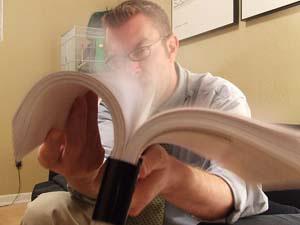A call for an AP-style ‘write-through’ for Web journalism
By Dan Gillmor
 Revisions, photo by Greg TurnerIn the journalism of tomorrow, we don’t need to think in the publication or broadcast metaphors from the age of literally manufactured media, where the paper product or tape was the end of the process.
Revisions, photo by Greg TurnerIn the journalism of tomorrow, we don’t need to think in the publication or broadcast metaphors from the age of literally manufactured media, where the paper product or tape was the end of the process.
When there’s breaking news, we should update as we learn more. And we should be clear about what has changed.
Why stop there? Why not apply this to features or lengthier pieces? After all, if Steven Spielberg and other Hollywood folks can create directors’ cuts of their movies, why can’t journalists continue to update and improve some of their own works?
This can be done both by professionals and citizen journalists. It should be.
You ask, what about the historical record?
That’s an easy one. Over at the much-criticized Wikipedia, every version of the article — everything down to the version where someone added a comma and hit the save button — is available to anyone who wants to see it. You can even compare adjacently edited versions side by side.
Let’s say I’m a reader who is new to, oh, the turmoil in Nepal, where the king is trying to avoid civil war with apparently modest political liberalization. Let’s imagine, in a parallel universe of journalism, that the New York Times did its first in-depth story on the troubles there a couple of years ago and has been updating it on the Web to reflect new events — this in addition to publishing current news stories.
Maybe, being fresh to the story, all I want to do is see the current version so I can catch up. Or maybe I’d like to read the the original article — call it the baseline copy — and then the current one to see what has changed. Or maybe I want to see them mashed together, with the changes highlighted using colors for additions and strike-throughs for deletions.
The same could work for a blog posting by some well-connected Nepali citizen who is covering the story from home. Do I want to go back through a year’s worth of postings? Probably not. But if he or she has an updated baseline posting, that would be another useful place to look.
The idea isn’t new, really. The Associated Press has been using what’s called the “write-through” forever — adding new information to breaking news and telling editors what’s new in the story. Let’s do that for everyone, on the Web page and in a comprehensive and easy-to-understand way.
Now making this work on the page is basically a software problem — if we want to do it. Maybe it’s a nontrivial problem, as technology people might say, but it’s definitely solvable.
Dan Gillmor is director of the Center for Citizen Media. This article is adapted from a talk at Columbia University’s School of Journalism in April 2006.
Photo by Greg Turner
